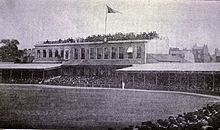Kennington Common
The large open space was often used for a variety of purposes by people living on the south bank of the River Thames.
The following year players were known to have used the Horns tavern as their clubhouse and in August 1726, a combined London and Surrey XI played a side led by Edwin Stead for a purse of 25 guineas.
People would gather at the common to listen to public speakers, both religious and political.
[4] On 10 April 1848, Irish Chartist leader Feargus O'Connor addressed up to 50,000 people over a petition in support of the Land Plan.
In 1746, the Jacobite officer Francis Towneley, along with other members of the Manchester Regiment, who had been captured during the failed Jacobite rising of 1745, were convicted of high treason and condemned to be hanged, drawn and quartered on the common on 30 July.
The lords of the manor and church of the parish were allowed to enclose some of the commons the land in the 19th century.
Under a scheme sponsored by the royal family, the remainder of the common was enclosed in the mid 19th century.

